October 4, 2023, by Nicholas Blake
History of Hallward Library Part 4: Legacy of the Library
2023 marks fifty years since the opening of Hallward Library at the University of Nottingham. In this fourth and final blog post we delve through the University archives and contemporary publications kept at Manuscripts and Special Collections to explore the history of this unique building.
The new University of Nottingham library opened in August 1973 (read more in History of Hallward Library Part 3: Building the Library), and the response was very positive.
The University of Nottingham Annual Report for 1974 commended the “outstandingly good building, whose functional performance over the past year has been warmly approved by users and Library staff alike”, with the coffee shop proving “embarrassingly popular” considering the small amount of space allocated to it, and attendance at the Science and Engineering Library falling as students flocked to the comfort of the new building.
The response in the student newspaper Gongster was equally positive, and although likening the exterior to a spaceship from Star Trek, the author declared the library “a superb place to work in”.
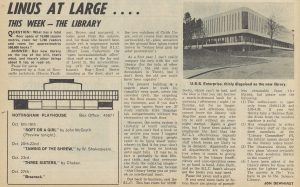
Review of the new University Library in the student newspaper ‘Gongster’, 16 October 1973, p.12. (University of Nottingham Collection, os.X.Periodicals Not 5.G14.8.F48)
The design of the new University Library was a massive hit in the professional industry. The Royal Institute of British Architects included it among their architecture awards for 1974, praising the building design and the sloping landscape “cleverly used to half bury the first floor and to conceal the service entrance”, and commending the interior as being “a warm and welcoming place that makes one want to stay and work”.
Sadly the library did not make it to the finals of Concrete Society Awards, though it was still highly commended for its external cladding of “high-quality precast concrete panels which have an exposed aggregate finish of white Cornish granite” which “enables the building to link naturally with the earlier neo-classical buildings of Portland stone which are nearby”, as well as being designed to be removed and re-used in the event of the building being extended.
Architect H. Faulkner-Brown noted that the form of the library was dictated by its function, and this is why the upper two study floor areas “have very small windows amounting to no more than vision slits”, with larger windows on the lower floors to aid passers-by to identify the use of the building by the presence of bookshelves and readers.

Staff member at University Library, c.1973. The card catalogue seen here was eventually replaced with electronic systems, beginning with SWALCAP in 1985. (UMP/6/2/22)

Photograph of a library staff member scanning in a book, c.1986. The introduction of SWALCAP in 1985 saw BBC Micro computers being installed and books in the library being assigned barcodes. (ACC 2044)

Photograph of the main lending desk at University Library, c.1986. (ACC 2044)
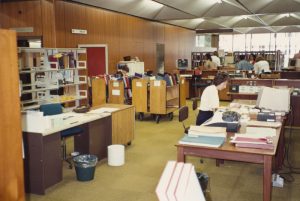
Photograph of the staff administration area of University Library, c.1986. (ACC 2044)
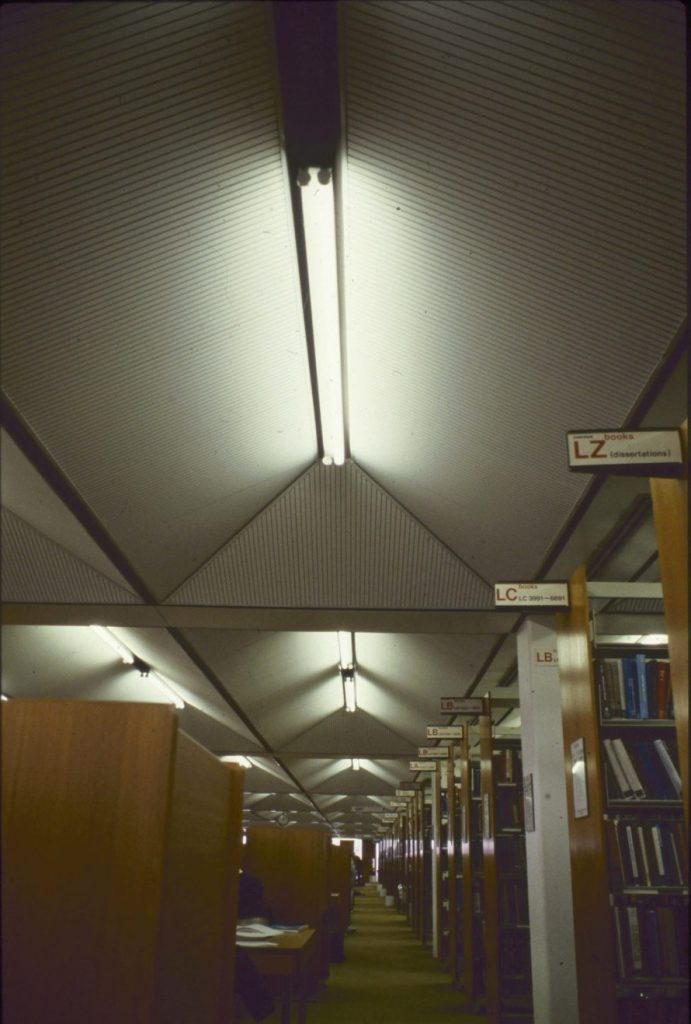
Photograph of book stacks and study carrells on level 3 of University Library, c.1986 (ACC 2044)
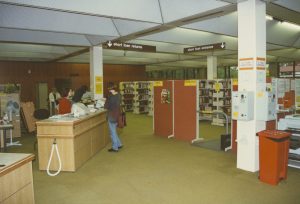
Photograph showing the entrance to the Short Loan Collection at University Library, c.1990s. (ACC 2044)

Photograph of the University Library help desk, c.1990s. (ACC 2044)
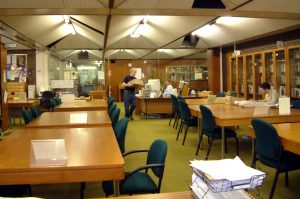
Photograph of the Manuscripts and Special Collections reading room on level 1 of Hallward Library prior to it moving to King’s Meadow Campus, 2006. Level 1 of Hallward Library was then refurbished with new facilities such as group study rooms, computer suites, and a cinema screening room. (MSC DP-00014)
Although the name of the library was officially the “University Library”, it was also known as the “Arts and Social Sciences Library” after the subjects it covered, and “Main Library” by staff within the Library Department. All this changed in 1989 when it was decided to name the library after the first Vice-Chancellor of the University, the same man who had been persuaded of the need for the building back in the early 1960s: Bertrand Hallward. Hallward himself attended the renaming ceremony, though the following year expressed some regret that the library which now bore his name had been constructed from reinforced concrete rather than brick, writing, “within a hundred years there may be trouble” (MS 519/5/2).
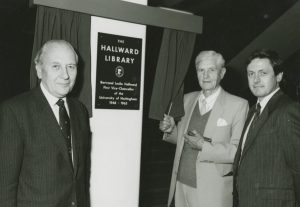
Photograph of (left to right) Basil Weedon, Bertrand Hallward and Sir Colin Campbell unveiling a name plaque for the Hallward Library, 1989. (ACC 3070/6)

Photograph of the bronze bust of Bertrand Leslie Hallward displayed in Hallward Library. (MS 802/9/3/1)
Fifty years on, Hallward Library is still one of the most distinctive buildings on campus, with its Brutalist structure belying the comforting, studious interior. Its first and second floor have been heavily remodelled over the years to reflect changing needs of students, with new technology helping users find resources they require quicker and easier.
It was visited by Queen Elizabeth II in 1981 as part of the University of Nottingham’s centenary celebrations (Gongster, 17 June 1981), the subject of an April’s Fool joke which suggested that cats would be introduced into the library, and in 2011 the café and Level 1 were used as filming locations for a song in Bollywood musical Teri Meri Kahaani.
Before the Covid-19 pandemic, Hallward Library recorded a peak of over 7000 visitors in a day during its busiest period, demonstrating that it continues to be both a quiet learning space and a bustling social hub.

Photograph of the exterior of Hallward Library, 2009. (MSC DP-00012)
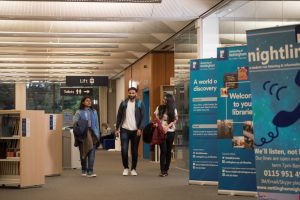
Photograph of postgraduate students walking through Hallward Library, 2019. (UoN ImageBank 37196)
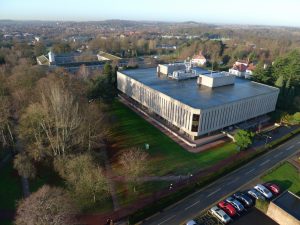
Hallward Library and surrounding area aerial view, 2009. (UoN ImageBank, 3504)
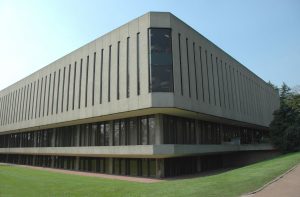
Hallward Library exterior, 2005. (UoN ImageBank, 397)
Resources consulted:
Annual report / University of Nottingham. Nottingham : University of Nottingham. (University of Nottingham Collection, Periodicals Not 5.A6.2)
Architectural review. Volume 156, number 931, September 1974. London : Architectural Press, 1974. (University of Nottingham Collection, Oversize Not 5.J35.32.H2 SC720459)
Concrete quarterly. No. 101. London : Cement and Concrete Association, 1974. (University of Nottingham Collection, os.Pamph Not 5.J35.32.H2 SC719603)
The gongster / University of Nottingham. Nottingham : Union of Students, University of Nottingham. (University of Nottingham Collection, os.X.Periodicals Not 5.G14.8.F48)
Nottingham University Library / Faulkner-Brown, Hendy, Watkinson, Stonor, architects. [1974?] (University of Nottingham Collection, os.Pamph Not 5.J35.32.H2 1000379247)
RIBA journal. Volume 81, no. 8. London : Royal Institute of British Architects, 1974. (University of Nottingham Collection, os.Pamph Not 5.J35.32.H2 SC720290)
MS 519: Personal and genealogical papers relating to Dr Bertrand L. Hallward (1901-2003), Vice-Chancellor of the University of Nottingham, and his family, 1925-1991
No comments yet, fill out a comment to be the first


Leave a Reply